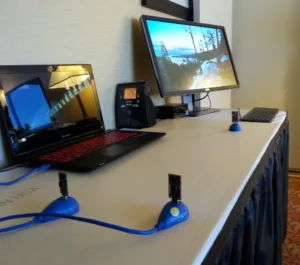Peraso (Toronto, Canada) is a fabless semiconductor company focused on the development of 60 GHz chip sets and solutions compliant with the IEEE 802.11ad specification. 60 GHz has been adopted for interoperability certification by the WiFi Alliance under the WiGig brand, which has seen strong industry endorsement by tech giants such as Samsung, Qualcomm and Intel. At CES 2015, the company showed a network operating using WiGig as well as a USB 3.0 adaptor.
The VC funded company ($20M to date) has about 40 people working on 60 GHz solutions for homes, enterprises and industrial/commercial applications.
One of the demos they showed us in their suite in the Westgate was a WiGig LAN. It consisted of three devices: two laptops and a monitor. WiGig is typically a point-to-point communication protocol, but mesh networks and beam-steering technologies can be employed to potentially allow the technology to be used for neighborhood Internet access. The steering can be used to avoid obstructions and still get connection from the pole to the house wirelessly. Plus, with new bonding methods being developed, it seems possible to enable Internet access speeds of up to 1 Gbps. Distances in this mesh topology can be from 100 to 300 meters.
President and CEO Ron Glibbery told us that each channel is 2GHz and within this they can create a bit stream running at 4.6 Gbps. In the demo, they were streaming a 4K video from one PC to the monitor while simultaneously using their WiGig USB 3.0 adaptor to transfer a file. The 220MB file transferred from one PC to the other in 7 seconds – incredibly fast.
Like competitor SiBeam, Pergaso has a USB transmit/receive chip set pair that the company claims is the smallest and highest performing on the market (at least before the SiBeam announcement at CES was evaluated). WiGig USB 3.0 adaptors are expected to play a fundamental role in the emergence of WiGig enabled devices in the 2015 consumer electronics marketplace.
The low latency aspect of WiGig is critical for interactive applications such as gaming, VoIP, and simple I/O functions such as mouse and keyboard.
Just prior to CES, the company released details of its new 60 GHz chip set with immediate production availability. The devices are available in two BGA versions, including the PRS1125, and the PRS1025, which includes an integrated antenna.
The PRS1025/1125 products have a silicon area is less than 5mm², and the packaged devices are 49mm² and 36mm² respectively. Key features of the product include:
- P1dB: 14dBm
- EIRP (integrated antenna version): 24dBm
- Receiver noise figure : 4dB
- Transmit EVM: -24dB (64QAM, single-carrier)
- Receiver Noise Figure of 5dB
- Frequency band: 57GHz – 66GHz
- Support up to MCS12 of IEEE802.11ad specification
- High-speed 1.5 Gb/s OOK mode
“We are one of the few companies in the world actually shipping a production version of a WiGig radio. This is a major milestone for the company”, noted Glibbery.
He also mentioned that the chips can be integrated into a USB dongle for wireless connectivity or built into devices. “There is also a power dial”, noted Glibbery, “which means you can turn down the power and range depending upon the application. In an application where you only need an inch or so of distance to connect, power can be as low as 300 mW”.
He said he expects to see the first integrated smartphone on the market by this Fall.

